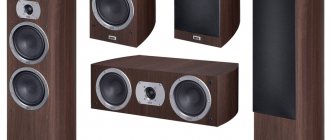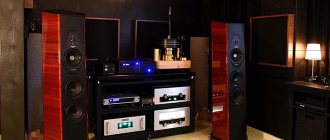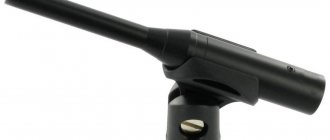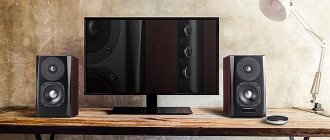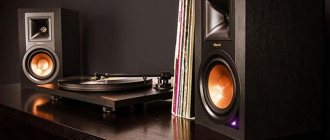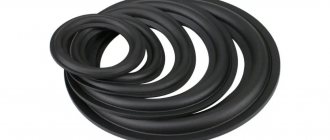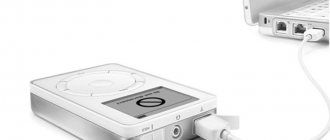Quite often, from the lips of many people, I hear an interpretation of approximately the following opinion - dynamics are not capable of anything, only planars/armatures/(insert the desired type of emitter) have the right to life. Well, in this text we will try to figure out what types of emitters exist for headphones and speaker systems. What do they offer and are the dynamics so bad?
Of course, for hardened audiophiles my text will not be a revelation, and I do not pretend to be. Also, I am in no way an engineer. I don’t want to teach tedious lectures on physics, so somewhere I won’t be completely precise and will present it quite generally for greater simplicity - please forgive me. It is not my goal to describe all existing types of emitters; there is plenty of information on most of them on the Internet. So I will focus only on those that are more often or less often used in headphones or full-size speaker systems.
The text will be extensive, so make some tea or pour yourself something stronger, warm up your tube amplifier (if you don’t have one, buy at least an amp9) and let’s get started.
Dynamic driver.
The most common emitter for a number of reasons. One of these is historical. Imagine, the first headphones were created in 1910! And the Sennheiser HD414 released shortly after that looks quite modern. On the other hand, there are now a great variety of technologies that allow one to elegantly solve certain problems in the production of dynamic drivers, which also influenced their prevalence.
Driver for Beyerdynamic T1 2gen
In a simplified version, the dynamic emitter is a ring magnet and a coil with a winding of many turns of thin wire placed in the magnet hole. Since the resistance of copper or aluminum per meter is negligible, you can calculate how many meters you need to wind on a coil to get 16, 32 or 250 ohms. The coil moves in a magnetic field perpendicular to the coils according to the Laurenz force. It is attached to a membrane, and the membrane, in turn, produces sound.
This is all placed in a single housing for structural integrity. In one form or another, just such a dynamic emitter is used in completely different equipment - from consumer-grade airpods to huge subwoofers the size of a room. The difference, roughly speaking, is only in size and use of materials.
If everything is so simple, why do other types of emitters exist and what motivates us to seek good from good?
Sensitivity.
Not that big of a problem. It is influenced, for example, by the strength of the magnetic field, the rigidity of the membrane and some other parameters; I will not dwell on them in detail. One way to increase sensitivity is to provide a stronger magnetic field. Everyone has probably heard with what pride some manufacturers still write about neodymium magnets - in fact, almost everyone has switched to them for more than 10 years.
What's the salt? For greater magnetic field strength and magnetization, which changes very little over time, various alloys based on iron, nickel and neodymium with different compositions and alloying additives are used. At the same time, the technology makes it possible to produce a variety of magnet shapes. Thus, in the Sennheiser HD800 or Beyerdynamic T1, the emphasis is placed on a non-trivial magnet, according to marketers. You can change the configuration of the coils, as well as the material of the conductive winding. Of course, all this affects the sound.
Membrane.
For a more natural sound and absence of distortion, the membrane should move as evenly as possible. In acoustic systems, and less often in headphones, a suspension made of a softer material is used around the perimeter of the membrane. At the same time, it itself should be as rigid as possible (however, there is still debate about what it should be) for uniform movement and as light as possible for fast response time and less inertia.
This is where the legs in various membrane technologies grow. Diamond-like carbon in Campfire Audio, Beryllium or Titanium in Periodic Audio and others, various coatings. Including Topology Diaphragm from Hifiman RE800 and RE2000, biocellulose membrane from Denon and ZMF, even more exotic silk, carbon nanotubes, etc. - all this is one way or another aimed at achieving the same result. And dynamic drivers are used in many devices, from microdrivers in the budget Kinera TYR to huge membranes in Adam speakers. And it's a matter of implementation.
As I already said, today many technologies make it possible to prepare a dynamic driver properly. And yet, those who do not know how to do this note in the minuses lower detail, speed and other parameters important for sound, which are allegedly a priori better with other emitters. But the speaker can pump a sufficient volume of air - that is why they are so often used, if not in the form of wideband speakers, then in hybrid designs in the low frequency range. For example, in my favorite Campfire Audio Solaris SE hybrids. AAW Canary has a pair of dynamic drivers at the low frequencies, connected in antiphase - thus, by working with one volume of air, distortion is minimized and better range control is achieved. But there are hybrid designs in rare full-size headphones.
Lack of character is a compliment
Since we called ourselves metalheads, let’s start with that. The composition “War Of The Gods” by Amon Amarth is precisely saturated with a hard, fast guitar rhythm and a machine-gun bass drum - and therefore is often used in tests and auditions.
And now every shot of the bass drum is designed clearly, effectively, and distinctly - and the same can be said about the guitar chords. And in the roar of Johan Hegg you can literally feel the vibrations of strained ligaments. At the same time, there is no deliberate analyticity in the sound - on the contrary, it is perceived as cohesive and musical.
The carbon headband looks very impressive, but the elastic material lacks torsional rigidity
In general, when listening to heavy genres, I was never able to find compositions where the Gatlings openly stumbled. But working out low frequencies here requires special explanation. The creators of these headphones do not operate with such concepts as abstract “bass” at all (the same is true for “highs” with “mids”), but pay attention to the transmission of specific musical instruments.
That is, the goal is not to shake your eardrums with low frequencies, but to reliably display the sound of a bass drum, floor tom, snare drum, bass guitar - and the list goes on. Just like at the top, what is important is not the spectacular crumbly “clack”, but the recognizable sounds of crash or ride cymbals.
Headphones combine design minimalism with high quality workmanship
Melodic power metal, like the German Edguy, also began to sparkle with fresh details and nuances - like watching a movie in 4K after watching an HD TV. But the presentation of progressive rock, especially one that was initially well recorded, seems much more advantageous - and here, of course, we must mention Pink Floyd and Wishbone Ash.
In the interpretation of the duo Gatling and 1862OCU, even such initially “unnatural” genres as, for example, synth-pop sound lively and natural. In the composition “Airplane” by Elektromonteur, massive electronic bass does not pummel the ears, but seems to dynamically massage the brain itself, and the vocals of the charismatic Mikhail Borzenkov (yes, that same one) are extremely outlined and placed in the foreground.
Chamber classics - for example, the album “JS Bach”, which I often mention. Oboenwerke. Alexei Utkin. Hermitage Chamber Orchestra" - presented by "Gatlings" no less impressively. The phrase about the “palpable trembling of the strings” has already become hopelessly banal, but now it’s not so easy to get it out of your head. But here the virtual sound “3D picture”, which clearly depicts the location of the musicians on stage, made a much greater impression.
The ability of headphones to arrange sounds in space in an informative way was confirmed by files from the test disk “Dr. Chesky's Ultimate Headphone Demonstration Disc”, where assistants “with tambourines” walk around a binaural microphone.
The pilot batch includes two expensive detachable cables from a Russian manufacturer
Finally, you can be original. Let's take a high-quality digitized magnetic album of the “Tikhoretsky Concert” by Arkady Severny and the group “Vstrecha”, recorded in 1979 in the local studio of Stanislav Safonov. The concert managed to become a cult among fans of vintage and “nostalgic chanson”.
I still remember the time when this album was played on reel-to-reel tubes like my Dnipro-14A. I listened to it on different radios and music centers and I will say that I have never seen such a high-quality and soulful elaboration of the characteristic hoarse-velvety voice of Arkady Dmitrievich and such an effective balance of instruments and volume.
The design of the emitters, the selection of materials, as well as production are exclusively domestic
Generally speaking, all those who believe that in the past the sound was warmer, the performers were more expressive, and the lamps were brighter - MyST Gatling will appeal to you with its honest and unobtrusive presentation, leaving you alone with nostalgia.
In fairness, it should be noted that there are areas for which Gatlings are contraindicated. These are all kinds of rap, dubstep, various “acid” genres - in a word, where it is not the naturalness of the sound that is valued, but the merciless piling of aggressive lows into the ears, but for this there are special headphones, which even feel like they have bass on cymbals.
The “native” branded DAC amplifier sang much more organically with the headphones than a number of devices from third-party manufacturers
Manufacturers often try to endow headphones with a certain specific and sometimes embellished presentation, highlighting “humps” and “dips” in the frequency response that caress the ear. MyST Gatling, in turn, had a peculiarity: the lack of a pronounced character - especially in conjunction with the same neutral source. At the same time, the sound still does not turn out to be bland and monitory, but, on the contrary, is perceived as very musical and comfortable.
Personally, I have always liked such an honest presentation, but I do not rule out that someone will miss the bright colors in the interpretation of MyST Gatling.
Tape emitters.
In the fight against damned inertia, the sound-emitting membrane is made lighter and lighter, essentially turning it into a thin ribbon. Hence the name of the whole driver division.
Planars.
The most common of them for a number of reasons. They are literally a little younger than dynamic drivers and are now experiencing a rebirth after their heyday in the 60s-80s of the last century. Generally speaking, the driver is a thin membrane with conductive tracks applied to it. It interacts with the magnetic field of permanent magnets and thus moves.
orthodynamic emitter
Depending on the presence of magnets on one or both sides, there are single-sided or double-sided magnetic systems. Also, the configuration of tracks and magnets distinguishes isodynamic drivers (Hifiman HE4, TDS-7) from orthodynamic ones (Yamaha YH-3). The latter have a circular arrangement of conductive paths.
However, Lvov engineers at Amphiton, and then at Rinaro, decided to combine all this and placed both isodynamics and orthodynamics on one membrane. Only in the Soviet n21/25/28s, and then Oppo PM 1/2/3 was it a combined track, and in the Rinaro both types of tracks are located on the same membrane. Although now there is little interest in these nuances, that is why a rather general definition of “planars” has been adopted. The tracks can be located on one or both sides of the membrane; for orthodynamic headphones, the configuration may provide (TDS-16) or not (Amfiton N-28c, Oppo PM3) a central contact.
Isodynamics | Orthodynamics | Iso + orthodynamics
There are a variety of experiments in this field:
- partial fastening of the square membrane only on two opposite sides
- additional corrugation or other methods of stiffening the membrane
- weight distribution by partial removal of material from the membrane during etching (Fostex T50)
- experiments with track configurations (zigzag for Fostex T50-RP, meanderless membrane for Audeze)
- width and material of tracks (Abyss)
- the material of the membrane itself, its thickness, tension,
- configuration of magnets and so on and so forth.
Thus, there are a great many subtypes of ribbon emitters. For example, the so-called “planamic” for Mee audio headphones of the same name. One way or another, the range of applications of planars is very wide. Also, they are used in acoustic systems as high-frequency tweeters (Adam), less often - for the entire range (Magnepan). In full-size headphones, planars can be found in all Audeze models and a lot of Hifiman models. And recently, they are increasingly appearing in TVs as broadband (Tin P1, UM ME. 1, Audeze iLCD3) or in hybrids for part of the range (IMR, oBravo).
AMT.
One of the interesting branches of isodynamics was invented by Oscar Hale. Now the driver bears his name, or is identified by the abbreviation AMT - Air Motion Technology. Essentially it is an isodynamic membrane folded like an accordion. As a result, in a magnetic field it does not move translationally, but compresses and expands adjacent folds, ensuring pumping of a larger volume of air. ESS has an exclusive lifetime patent; the first products with a driver using Hale technology were released back in 1972.
It is usually difficult to capture the entire range, which is why a number of high-end speakers use these drivers as tweeters. They are also used in the same capacity in some models of full-size and in-ear (IEM) oBravo headphones. Among the broadband solutions are HEDDphones in the full-size segment, vintage ESS Mark 1, and the world’s only in-ear Project Heaven, widely known in narrow circles.
It is possible without tracks at all.
For example, Ribbons (Raal), where the entire membrane is conductive, corrugated, suspended on both sides, and magnets are located not in front and/or behind the membrane, but on the side.
However, we can talk about the topic of tapeworms for a very long time and a lot, so we will continue to move in the direction of reducing the weight of the membrane.
By purpose
Depending on where and for what purposes you will use headphones, you can also distinguish several types.
- Stationary headphones
, which are commonly used at home. What are they? Most often they are full-size, open (less often closed) and high-impedance, if there is an amplifier.
- Monitor headphones
, used for work in the studio: full-size, high-impedance, for work on stage: reinforced in-channel.
- Gaming headphones
for gamers look like this: full-size with a microphone. They are not suitable for listening to music, since their purpose is to sit comfortably on the ears for a long time and have “raised” bass (for explosions, gunshots, etc.).
- Portable headphones
, which are used to listen to music from a phone, player, etc. They are compact, low-impedance with high sensitivity. The form factor can be any, as they say, according to taste and color...
- A headset
is a compact headphone with a microphone that can even have one “ear” and is used for hands-free conversations.
- Sports headphones
are most often in-ear, but recently they have been actively using on-ear headphones, namely AirPods, and you can also find on-ear headphones among them. Requirements for sports headphones: fit securely in (on) the ears when running without creating discomfort, have additional protection from water (headphones for swimming) and dust, be wireless. Sound quality is usually not given enough attention here.
All characteristics of headphones, even those that seem to relate only to design, affect the sound they produce. Select several models that meet your needs and tasks that you want to solve with headphones, then compare the selected models with each other through live listening. Only your ears will tell you the right choice. Happy shopping that won't disappoint you!
Electrostatic emitters.
There is less information here, especially regarding use with headphones. So we take a shovel and dig.
In planars, in rare cases, the thickness of the membrane approaches that of electrostatic drivers, but this is rather an exception to the rule. Due to the weight of the membrane and the price of this type of driver, an aura of semi-mystical high-end with hitherto unprecedented sound levels has been successfully created around the electrostats.
I won’t say once again that everything depends on the implementation of the technology. Let's delve a little into the history of electrostats. Nowadays, the issue of electrostats in the headphone segment is successfully dealt with by essentially one and a half companies, and the Japanese Stax have become synonymous with them. They released the first such model in 1958 and continue to successfully produce them to this day. And the first patents in this direction were back in 1921, and, naturally, related to the field of speakers. Besides the mentioned Stax, for example, the companies Martin Logan and Quad are quite widely known in this direction.
As for other companies producing headphones, electrostats in their range are rare and are rather an exception to the rule. Among the relatively successful and insanely expensive ones is the Sennheiser HE 90 Orpheus.
What's unique about this technology? This is an ultra-thin membrane of a couple of microns. So thin that putting tracks on it means significantly increasing weight, and therefore inertia. It is also impossible to metalize the membrane film to polarize it or polarize it in any other way. Well, or rather it is possible, but then the membrane will either be thicker (not necessarily) or the efficiency will be lower. And these will already be electrets. More on them a little later.
Electrostats are essentially a lightweight version of “planars in reverse.” Only in the case of planars do we have a stable direction of the external magnetic field. The driving force of electrostatic emitters is the current changing direction, and, as a consequence, the Lorentz force. In electrostats, a stable, high charge is applied to the membrane. The charge itself is supplied to the stators in antiphase and changes from “+” to “-” several hundred times per second. Under these conditions, willy-nilly, the membrane has no choice but to oscillate back and forth or hang itself. Well, or left or right - which way you look at it.
It would seem that if everything is so simple, then why didn’t other types of emitters die out like dinosaurs? Well, if we could make access to electrostats in all sources, is it so difficult? Why not? Because it's not that simple.
Higher voltage requires higher volume. But its ceiling is limited by the breakdown voltage of the air. When it is reached, “lightning” will occur and, most likely, everything will burn to hell. Okay, not so dramatic and with a little less special effects, but it will still burn. And this voltage also depends on air humidity. I once had a friend burn out his Stax due to constant use in a humid climate. So you need protection from moisture. And dust too, its particles are also attracted to both the stators and the membrane. Therefore, at exhibitions you can often see Stax in a box with low humidity. And special caps are provided for their storage.
But in fact, a voltage of several hundred volts and a low current are sufficient to operate. A person may not even feel it. This is a security issue. And sensitivity (read volume) strongly depends on the distance between the membrane and the stator. In addition to the need to make this distance as small as possible, this imposes several restrictions. A shorter distance means a smaller amplitude of movement, worse low-frequency response.
headphone emitter STAX SR-009
A shorter distance means less potential is needed for the aforementioned “lightning”. Contrary to popular belief, the membrane does not move piston-like, but bends, forming a three-dimensional parabola. This creates another negative point - the concentration of charge at one point due to its migration along the membrane. To avoid this, it is usually made of high resistance. It will not be possible to pull the membrane very tightly - in addition to unwanted resonances, the low-frequency response decreases.
In addition, to match the volume of the left and right emitters, a perfect match of dimensions is required, which requires high manufacturing precision. The configuration of the stators also matters (usually they are thin perforated metal plates) because they also act as dampers at the same time. And so on and so forth. But that's not all. Schematically, the boost converter is drawn in the form of a transformer, and it would seem that it can be made of any size, but no. A more complex system is needed. That is why electrostats do not play without a special “giver”.
Considering all of the above, it is not so strange that in the form factor of electrostatic emulators you can count on your fingers: Stax SRS001, 002, 003 and Shure KSE1200, KSE1500.
Electret emitters.
Wait, you say, what about the electrostatic tweeters, say, in the previously mentioned AAW Canary? The fact is that the physics is the same for Stax, and for AAW, and for Sonion, which came up with such an emitter. And they came up with just the mentioned electrets. Or rather, they rethought it, because it was invented just as long ago, and such headphones were, for example, in the mentioned Stax. So what did Sonion do and what are the differences?
They secured the membrane by placing the driver in a closed housing, not much different in appearance from an armature one. Of course, the area and amplitude of movement have greatly decreased, so only the HF range remains. The membrane area also affected the ability to accumulate electrical charge. The need for polarization voltage was circumvented by polarizing the membrane. It would seem that the differences are minimal, then why is the efficiency lower and electrets are technologically inferior to electrostats?
To begin with, the ability of a material to accumulate polarization charge is limited. So the charge of the polarized membrane is lower than the charge of the membrane to which the polarization current is applied. As a result, all other things being equal, there is less force of interaction with the stators.
But if so, then how was it possible to bypass the need for polarization voltage on the stators? A smaller amplitude of movement made it possible to make a shorter distance. And also the same transformer that is shown in the diagram and renderings. If the headphone housings are transparent, you can also see it.
Now let's go back a little. Why all this suffering? To reduce the weight of the membrane. Why weight loss? Less weight means less inertia, shorter response time, higher detail, SOI of the order of 0.05%, etc.
So, in magnetism there is also inertia. In a transformer, the voltage increase occurs due to the same Lorentz force. And the more turns, the larger it is. Thus, in the transformer we have a total number of turns that is not particularly inferior, and maybe even superior, to that of dynamic headphones. But if there the influence of this factor in comparison with the others is not so significant, then here it is more noticeable. Also, one of the negative aspects is that the membrane demagnetizes over time. This happens when touching the stator (usually this moment is taken into account) or over time. It's like a magnetic tape that could record as many as one album, if it wasn't very long. This is in case anyone doesn't know.
True, unlike cassettes, the electret membrane loses its charge much longer. For vintage headphones they quoted a value of about 15-20 years, now it is noticeably higher. So don’t worry, a family heirloom in the form of a grandmother’s wedding ring and custom electrets for the grandfather’s HF will still please the granddaughter. After Reshell, of course.
In addition, technically electrets are a subtype of electrostatic emitters. At the same time, calling all this electrostats is much more profitable from a marketing point of view. That’s why both driver manufacturers and those who use it elsewhere do this.
Electrostats also include condenser emitters, but since they are not used in headphones, let’s skip this point and move on.
According to acoustic design
Based on their acoustic design or design, all headphones can be divided into three types: closed, open and semi-closed (half-open).
- In closed-type
, the driver emits a sound wave only into the ear; they are sealed from the outside. Closed-back headphones are great for immersing yourself in sound. That is, people nearby do not hear the music played in the headphones, but the one who is wearing the headphones does not hear external sounds. This type of sound insulation is called passive.
Advantages:
- tight fit and excellent sound insulation;
- lack of audibility for others;
- juicy bass;
- detailed sound even at low volumes.
Flaws:
- the sound is not realistic enough compared to open headphones;
- unsafe for listening on a busy street;
- Listening for a long time may give you a headache.
- In open-back headphones,
the driver emits sound in all directions. In them, the listener is not isolated from the noise, just as those around him are not isolated from his music. Compared to closed-back headphones, open-back headphones will give you better sound quality because the sound is not distorted by reflections inside the sealed housing.
Advantages:
- the most realistic, uncolored and clear sound;
- safety, which consists in the ability to hear warning signals, for example, from a car;
- comfortable ear pads when your ears don’t sweat and your head doesn’t hurt.
Flaws:
- low noise insulation, which does not allow you to fully immerse yourself in listening;
- irritation of others with sound from headphones;
- The bass sounds worse than with closed headphones.
- Obviously, half-closed or half-open
(these are the same thing) headphones have partial noise isolation. These headphones have a closed cup with holes. Often, such headphones are purchased for professional activities, as they provide some sound insulation and realistic sound with the possibility of long-term use. However, you won’t be able to completely immerse yourself in the music, since they still let in some external noise.
Which headphones should you choose? The answer to this question depends on the tasks at hand and the acoustic environment in which the headphones will be used. If you plan to listen to music with headphones in noisy places (transport, studio while recording vocals or instruments), then it is better to choose closed headphones. When the sound from headphones does not bother anyone (for example, at home or when you work alone), but external noise can warn, for example, of danger (on the street), you can use open headphones.
Armature emitters.
And then an alternative view of all this happiness. Let's increase the sensitivity using a magnetic field, and reduce the weight of the membrane by reducing the size, while simultaneously increasing rigidity.
Greater magnetic field strength gives greater sensitivity, and as a result, the response speed of the membrane. This type was also invented in the 20s of the twentieth century, and became particularly widespread in hearing aids due to the higher volume and compactness of the emitter.
Etymotic was one of the first to use it in games, releasing its legendary ER4s in the early 90s. Those who couldn’t fit them or who didn’t have the diligence to choose attachments and the imagination to go beyond the stock ones cried out that there was no bass and the range was limited to the midrange. This is roughly how multi-drivers appeared. One of the first was, oddly enough, professional monitors created by Van Halen technician Jerry Harvey. His name is now widely known.
But it’s not a problem to cram a bunch of drivers, the problem is to coordinate them. Typically, a crossover is used for this, distributing the sound across frequencies and feeding them to each driver individually. Rarely - non-crossover technology. At the same time, there are also dual (paired) reinforcement emitters. They have completely separate internal chambers, but a common sound guide. And in general, there are already quite a few varieties of reinforcement emitters, and progress clearly does not stand still.
But even this does not always suit listeners, so over time hybrids appeared - a dynamic driver for the low frequencies and one or more reinforcement drivers for the midrange/high frequencies. However, this design has already become a classic and recently, at best, part of the range is reserved for the armature driver, giving it to HF electrets, piezoceramics or other types of drivers.
By design
Based on design, fit, and form factor, there are three types of headphones: full-size, on-ear, in-ear, and in-ear.
- Over-ear headphones
are also called surround, monitor or arc headphones. They have a headband and large ear pads that completely cover the ears without pressing them to the head. It's rare, but you can still find headphones without ear pads (for example, AKG K1000). Over-ear headphones are easy to use as they have a comfortable fit, but they are bulky and not suitable for listening with a headgear. Over-ear headphones are versatile. Closed monitor headphones do not have the highest noise insulation; their sensitivity is insufficient for portable sound sources, so they require amplification. In this regard, monitor headphones are used mainly indoors, for example, in recording studios.
- Over-ear headphones
are more compact, making them more portable. The ear pads are pressed tightly against the auricle, the speaker is located closer to the ear, so the sensitivity of on-ear headphones is usually higher than that of full-size ones. Over-ear headphones are ideal for short periods of use due to the pressure of the ear pads on the ears.
- In-ear (vacuum) headphones
are inserted directly into the ear canal, creating something like a vacuum there, and are held there thanks to silicone ear pads. Due to the proximity of the emitter to the ear, these headphones allow you to listen to music quietly while maintaining sound clarity. Such headphones are often used on the street, in transport, during sports, etc.
Advantages:
- compactness,
- passive noise isolation (closed headphones),
- versatility,
- high sensitivity.
Disadvantage: Listening to music at high volumes can damage your hearing.
- In-ear headphones (pills)
are headphones that are placed in the auricle rather than inserted into the ear canal. Most often they are open or semi-open, less often closed, but they still allow external noise to pass through due to their loose fit to the ear canal. The advantages include compactness and low price (with the exception of AirPods). Earbuds are convenient to use outdoors, but in transport the sound will disturb other passengers if the headphones are open.
Electromagnetic emitters or Siren Armature.
But we will return to piezoceramics later, but for now we will consider a driver type that was once quite fashionable (mainly thanks to Ortofon), called Siren Armarure. In general, reinforcement drivers are slang from the English Balanced Armature, i.e. emitters with a balanced armature. But Siren Armature is a cross between a conventional dynamic and an armature driver. Rather, it resembles an electromagnetic emitter or a dynamic driver in reverse. Those. the membrane moves under the influence of the interaction of the field of the magnetic core with a stationary electromagnet, to the winding of which the output signal of the source is supplied. This compromise allows you to quite well combine the speed, definition and detail of the armature drivers with the density and physicality of the speaker - the membrane is larger.
However, the technology never gained much popularity. Despite the fact that historically this type of emitter is older than dynamic, such emitters remain only as “tweeters” in various special equipment.
Conclusion
In their price segment, MyST Gatling is designed to compete with premium isodynamic models, and beginners have pretty good chances, considering that such a purchase is not made spontaneously, but more often after scrupulous listening and comparisons. Here, “Gatlings” can offer their signature accurate and unembellished presentation, and for wealthy fans of high-speed heavy genres, the choice is completely narrowed down.
Advantages: high detail. Natural, unembellished sound. Confident work with almost any musical genre.
Disadvantages: The carbon headband could be stiffer in terms of torsion.
Official website: MyST Gatling
Price: 133,000 rubles
Piezoceramic driver.
Most of the mentioned types of emitters use the conversion of electrical energy into magnetic energy, but there are other methods. For example, the piezoelectric effect, i.e. the occurrence of mechanical deformations under the influence of electrical voltage.
Piezoceramic emitters are a metal plate with a layer of piezoelectric ceramics deposited on it, which is coated on the outside with a conductive coating. Widely used as buzzers in watches, toys and other devices. And sometimes as a tweeter in headphones, for example, 1more H1707.
Beyerdynamic DT 770 Pro
Professional closed-back headphones for diffuse field in three modifications - 32, 80, 250 Ohm. As reviewers note, the DT 770 Pro is a compromise between sound insulation and sound quality, with a premium on sound. The manufacturer positions the model “for responsible monitoring of music and sound.” Price - 16,200 rubles.
Pros:
- The structural elements are completely metal.
- Housing made of anti-resonating plastic with internal damping.
- Removable ear pads made of memory material. Like the YAMAHA HPH-MT8, it can be cleaned and even washed.
- FI acoustic system to improve the quality of low frequencies.
- Cable for all modifications made of oxygen-free copper with high-strength external insulation. For 250 Ohm - a twisted 3 m cable, for 80 Ohm - a 3 m straight cable, for 32 Ohm - a straight 1.6 m cable.
- 32-ohm and 80-ohm can be connected to a USB-powered sound card.
- Gold-plated mini-jack, like the AGK K712 Pro.
- According to the frequency response: good uniform midrange with an emphasis on the edges of the lows and highs.
- The sound is detailed, the stereo panorama is wide open, the sound is 90-95% natural.
Minuses:
- Unfoldable, like the Audio-Technica ATH-M50x.
- Fixed connection, difficult to change if necessary.
The model is in great demand due to the quality of sound delivery, reliability of assembly and low price. In sound they are similar to the YAMAHA HPH-MT8 with a “mixture” of a signature touch. Beyerdynamic DT 770 Pro 32 omh are designed for connection to portable equipment. Some people use 32 Ohms to listen to music from a smartphone or tablet; distortion and harmonics do not drop much, but the low frequencies begin to wheeze at maximum volume, and the highs hurt the ears. If you set the volume to medium, then, according to reviews, there will be decent sound.
Beyerdynamic DT 770 Pro 80 ohm already requires a headphone amplifier. They are popular for listening to guitar vocals, are considered universal in connection, and are often used for recording sessions.
For professional equipment, it is better to take Beyerdynamic DT 770 Pro 250 ohm; they fully reveal “live” sound and are recommended for precise mixing.
Reviews on Yandex.Market
Results.
Of course, there are other types of emitters, but they are used even less frequently, so I won’t talk about them. Let me sum it up better. Technologies do not stand still, and if initially dynamic drivers were a necessary evil, now their use is not at all necessary, but thanks to many advantages, it is quite common. There are also many other types, each with its own technological pros and cons. But in the top segment, everything depends on the capabilities of the manufacturer. Very often, determining the type of emitter by sound is not possible, and the desired sound is determined not by the type of driver, but by its implementation in a separate device. So “love the music, not the equipment.” And see you soon in the next texts.
What are magnetic planar headphones
Magnetic planar headphones are a type of Hi-Fi class playback equipment. The design uses a special Hale emitter.
The specific design of planar gadgets ensures a complete absence of distortion. The devices reproduce clear sound with a uniform amplitude-frequency response (AFC). The devices are large in size and also expensive. Planar emitters are often installed in large overhead models, but if desired, it is not difficult to find in-channel devices.
Alone
With an announced price of 15,000 rubles, MyST IzoEM-1 are among the most affordable isodynamic headphones. This immediately suggests a comparison with the Tin Audio P1 in-channel isodynamics, which look more impressive, sit more comfortably, are undemanding to the source and, in addition, cost a little less. Even with a regular smartphone, these headphones produce rich, colorful and detailed sound and are great for everyday wear, but when connected to really high-quality and powerful equipment, the sound turns into rough and noisy with ear-piercing highs, and in audiophile territory they can hardly be called competitors.
Even the youngest magnetic-planar Audeze iSINE 10 costs almost twice as much, but they benefit from the brand image, eye-catching design and ability to play well with most players and smartphones. But it’s better for listeners to determine the difference in sound themselves - opinions may differ.
It is important to add here that although MyST IzoEM-1 was announced as a serial product, it can hardly be called “commercial” - rather, it is a “flag demonstration” in a new segment of in-channel isodynamics, testing the reaction of potential consumers and testing new technologies. The company plans to bring to the market a more advanced and source-friendly model, but, alas, at a far from affordable price.
Don't say you weren't warned
On its website, the manufacturer honestly notifies potential customers that not every portable player, not to mention smartphones, can handle the MyST IzoEM-1 model with an impedance of 2.5 Ohms and a sensitivity of 100 dB/mW. But you still need to verify this for yourself, so for testing I stocked up a scattering of sources with different characteristics.
I was attracted to the well-deserved Hidizs AP100 because this inexpensive portable player copes with most headphones and somehow even squeezed out acceptable (although far from ideal) sound from the Fostex isodynamic line, known for its “tight” character. But this time, instead of a comfortable sound, I heard a quiet, flat rattling sound, like nameless “plugs” from a street stall. A “sandwich” of the Fiio X1 player and the Fiio A3 portable amplifier (in hi-gain mode) made the sound a little louder, but not better at all.
Next, the “musical” smartphone Highscreen Boost III entered the battle, in which a combination of a DAC and an amplifier (ESS9018K2M and ADA4897-2) works correctly with many low- and high-impedance headphones. The result is almost the same - quiet and inexpressive on any musical material. Another “musician” - the LG V20 smartphone with a proprietary Quad DAC architecture (tailored mainly for high-impedance devices) based on the ESS Saber S9218 - also failed.
Last photo for memory – as it turned out, these sources are completely unsuitable for headphones
Unfortunately, on this day I was not able to quickly select the “heavy artillery” of the portable, which, for example, includes the expensive and powerful Lotoo Paw Gold 2022 player (the company itself names the QLS QA361 as an example of a compatible device), some DAC-amplifiers from Centrance and Chord and other uncompromising solutions. In short, we recommend focusing on an output impedance of less than 1 Ohm and a power of 300–500 mW per channel.


